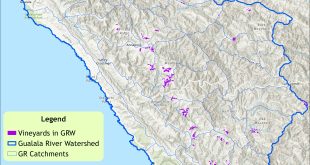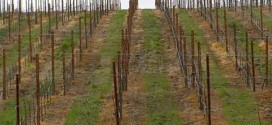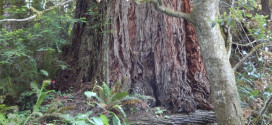| This article was published in the Independent Coast Observer on January 31, 2003. |
Courtesy Independent Coast Observer, Gualala, CA
Conversion of forests to vineyards proposed between Manchester and Cazadero could have many unforeseen effects, according to scientists who spoke to about 80 people at a meeting of Friends of the Gualala River last Wednesday.
“The issue tonight is not about wine, it’s about the forest,” and whether it is appropriate to lose forest for any crop, said Chris Poehlmann from Annapolis where grapes are gaining an ever-larger foothold.
The most important product the forest is water, he went on. A vineyard compared to a forest would be a desert, and not, as one applicant wrote, “a crop rotation.”
Grape pressure began in Annapolis when Kendall Jackson bought land and planted vines on land that was mostly apple orchard. They did no forest conversion, but those who follow them do. Some interests come from as far away as Spain and Minnesota. “Annapolis isn’t as remote as we all thought,” said Poehlmann.
He brought a sheaf of studies showing that current forestry rules are inadequate to protect resources, especially from cumulative effects.
Four years ago 10,000 acres of grapes were proposed for the former Coastal Forestlands Longview Tract in the coastal hills of northern Sonoma and Southern Mendocino counties. Now, promoters say it would be less than 5,000 acres, possibly financed by the California Public Employees Retirement System. Poehlmann advised people to lend support to organizations that fight deforestation, and to write to state and county officials.
Greg Giusti, UC Extension Forestry Advisor, said that individual land use practices lead to cumulative effects. He showed a slide of a small dam that would not be too bad a barrier for fish seeking to go upstream to spawn. Then he showed a slide with 1,200 known dams in California marked in red. The scientific record since the 1880s shows decline of salmon as dams increased.
Redwood is a remnant species, Giusti went on. It extended over much of North America in another time, and showed up in California 5.3 million years ago. Redwoods grew 66.4 million years ago in Wyoming. They live on where it is cool, generally near the coast, in company with other trees.
Redwoods lived through low-intensity fires every seven years or so that did not burn them down. Redwood forests repaired themselves one or a few trees at a time. There is little evidence of large-scale destruction.
Since modern logging started in the redwoods in the 1860s, 94 percent of the old forest has been converted to something much younger. Giusti showed historic photos of logging in the Gualala watershed collected by Save the Redwoods League.
Removing the oldest trees from the forest removes the nesting sites for marbled murrelets, birds that are still around and are seen flying here. They raise their young on broad limbs high in trees, and they are affected by conversion of the structure of the forest.
Large hollow trees called goose pens provide nesting sites for bats. The red-backed vole is another dweller in old forest. It spreads spores of fungi that help tree roots absorb nutrients. No scientific work describes the invertebrates of the redwood forest. We know that when we change structure, many organisms have difficulty in adapting, he said.
Oak woodlands conversion is not as regulated as conifer conversion, Giusti added. All these conversions chip away at the forest.
The next speaker was Adina Merenlender, who specializes in advanced mapping. Using these tools, she seeks to define cumulative effects, such as the infilling of pools with fine sediment in specific reaches of anadromous fish habitat.
One series of maps and charts shows movement of animals along streambed corridors in the Russian River watershed. Remote cameras recorded the animals that passed by. Along streams with the most cover, animals like foxes and bobcats trip the camera. In denuded streambeds raccoons and domestic cats prevail.
To give people an idea what 3,200 acres of vineyards look like, Merenlender showed a map of vineyards along Highway 101 extending from the north end of Cloverdale to the south end of Geyserville.
The portion of the Longview tract that lies in Sonoma County, she went on, is larger than all the protected lands in the county.
The sought-after vineyard microclimate is found on top of hills; Merenlender showed an elevation map to give an idea where development pressure is. Slope is a determinant; the Dunne Report released in 2001 shows that larger parcels and steeper slopes are more likely to produce significant adverse effects in a watershed.
Toxicologist Marc Lappé said that vineyard conversions cause increased runoff. This has a cumulative effect on anadromous fish that is compounded by toxics used in viticulture.
We now know, he went on, that deforestation creates a major disruption in soil microclimate and life forms. The chemicals used will aggravate it. Herbicides have unforeseen effects, especially when used with other chemicals. Some work together to become much more toxic.
Such interactions can reduce reproduction in mice, animals at the base of the food chain. Roundup® is now known to be much more toxic than we thought; it holds back cell division, for one thing, he said. Pesticides bind to soil particle that wash into streams and end up in the nesting areas of anadromous fish.
The fungicides used in viticulture are the most toxic used, Lappé went on. Many are cancer-causing and can increase miscarriages and birth defects. Undesirable fungicides are found on grapes and raisin crops.
The problem is the high chemical dependency of the grape crop. These chemicals were not present in redwoods, or in tanoak and other hardwoods “Chemical dependency adds insult to injury in the environment,” Lappé concluded.
Plant ecologist Peter Baye has worked for the Army Corps of Engineers on impacts on wetlands. Now that he is relocating to Annapolis, he is looking at uplands. The forest takes care of many wetland functions, such as filtering water, he said.
Examining on application for a vineyard conversion, Baye asked himself what would happen if, as the applicant stated, no sediment washed off the land? There would still be damage to streams because more nutrients would reach them and increase algae, which form long strands, sink to the bottom and cut off light. Forests act a a nitrogen filter, so streams that flow through forests do not have algal mats in them.
Many rare plants occur in remnant populations in the Annapolis / Cazadero / Plantation triangle. More may exist that people have not identified yet. As it is now, there are many refugia from which remnant populations can spread.
Vineyard conversions destroy such biodiversity; foresters may not even spot it. Insects that live in the soil can be pushed to extinction without ever being inventoried. Conversion can eliminate all refugia along the ridgetops. Most of the plant populations here are, like redwoods, remnants of other biological eras.
Vineyard conversions represent a fundamental change in the way terrestrial vegetation affects steams, Baye concluded.
A question and answer period followed, touching on vegetation burning associated with vineyard conversion, endocrine disruption by pesticides, the denial by the Board of Forestry of the Cassidy timber harvest plan east of Gualala, the legality of vineyard conversions, and the future of this area as another Santa Cruz.
FoGR President Tom Cochrane invited everyone to stay for a party to celebrate the withdrawal of Ric Davidge’s applications to take water from the Gualala and Albion Rivers and ship it south in water bags.
 Friends of Gualala River Protecting the Gualala River watershed and the species living within it
Friends of Gualala River Protecting the Gualala River watershed and the species living within it


